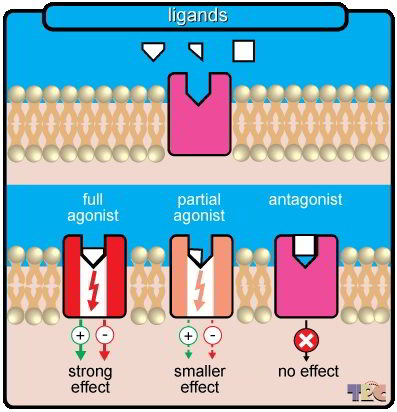Ligands
The compounds that bind to receptors are called ligands and are categorized by their interaction type:- Agonists (sometimes called full agonists) are ligands that bind to a receptor and cause it to activate and produce a biological response (see Figure 1).
- Partial agonists bind to the receptor but only cause a partial effect (see Figure 1). THC is a partial agonist of both CB1 and CB2 receptors.1, 2
- Antagonists do not exert any effect at the receptor level (Figure 1). This means that, for example, in the presence of an antagonist at the receptor, the action of exogenous or endogenous agonists cannot happen.
- Inverse agonists cause an opposite action to that of agonists.
- Allosteric modulators are ligands that, upon binding, make receptors either more or less receptive to the effect (e.g. agonistic) ligand. This effect is called a positive or negative allosteric modulation respectively. It is thought that CBD’s THC-inhibiting effects are due to allosteric modulation by CBD on the CB1 receptor.3 Also, other cannabis compounds, such as terpenes, are thought to give allosteric effects during an interaction of THC with receptors.4
 Figure 1: Ligand binding – Ligands are substances that bind to a binding-place, or a receptor. Each receptor in the body is recognized by an endogenous ligand (e.g. an endocannabinoid or a hormone). The ligand is then called an agonist. Agonism is the production of a response by a receptor after ligand-receptor interaction. The intrinsic activity of a full agonist is defined as equal to 1. Some of the endogenous agonists or derivatives are used as drugs (e.g. growth hormone, adrenaline).
Besides these full agonists, partial agonists also exist. Partial agonists have an effect on the receptor, but the resulting response is always smaller than the effect of full agonists. The intrinsic activity lies between 0 and 1. Full and partial agonists often have similarities in their chemical structure. Antagonists are ligands that bind to a receptor, but they do not elicit a response. In fact, antagonists block the receptor from the agonists and thus inhibit the action of the agonists. The intrinsic activity of an antagonist is 0.
Figure 1: Ligand binding – Ligands are substances that bind to a binding-place, or a receptor. Each receptor in the body is recognized by an endogenous ligand (e.g. an endocannabinoid or a hormone). The ligand is then called an agonist. Agonism is the production of a response by a receptor after ligand-receptor interaction. The intrinsic activity of a full agonist is defined as equal to 1. Some of the endogenous agonists or derivatives are used as drugs (e.g. growth hormone, adrenaline).
Besides these full agonists, partial agonists also exist. Partial agonists have an effect on the receptor, but the resulting response is always smaller than the effect of full agonists. The intrinsic activity lies between 0 and 1. Full and partial agonists often have similarities in their chemical structure. Antagonists are ligands that bind to a receptor, but they do not elicit a response. In fact, antagonists block the receptor from the agonists and thus inhibit the action of the agonists. The intrinsic activity of an antagonist is 0.
Illustration and caption taken with permission from TRC Pharmacology Database.
References:- Grotenhermen, Franjo (2003). Clinical Pharmacokinetics of Cannabinoids. Journal of Cannabis Therapeutics, 3(1), 3--51.
- Grotenhermen, Franjo (2004). Clinical Pharmacodynamics of Cannabinoids. Journal of Cannabis Therapeutics, 4(1), 29--78.
- Laprairie, R. B.; Bagher, A. M.; Kelly, M. E. M.; Denovan-Wright, E. M. (2015). Cannabidiol is a negative allosteric modulator of the cannabinoid CB 1 receptor. British Journal of Pharmacology, 172(20), 4790--4805.
- Kenakin, Terry P. (2012). Chapter 5 - Allosteric Drug Effects BT - Pharmacology in Drug Discovery. Pharmacology in Drug Discovery (81--103). Academic Press.
- Izzo, Angelo A.; Borrelli, Francesca; Capasso, Raffaele; Di Marzo, Vincenzo; Mechoulam, Raphael (2009). Non-psychotropic plant cannabinoids: new therapeutic opportunities from an ancient herb. Trends in Pharmacological Sciences, 30(10), 515--527.
- McPartland, John M.; Duncan, Marnie; Di Marzo, Vincenzo; Pertwee, Roger G. (2015). Are cannabidiol and Δ 9 -tetrahydrocannabivarin negative modulators of the endocannabinoid system? A systematic review. British Journal of Pharmacology, 172(3), 737--753.
_logo.svg)